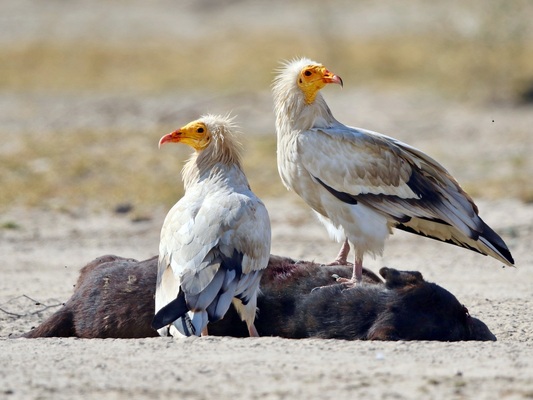Egyptian Vulture Bird Details
Neophron percnopterus
Egyptian Vulture
Misr Giddh
Carl Linnaeus in 1758.
Accipitriformes (HAWKS, EAGLES and KITES)
Accipitridae
Neophron
- Africa (Egypt, Morocco),
- Europe (Spain, Greece),
- Middle East ( Israel, Turkey),
- Asia (India, Pakistan).
Appearance :
The Egyptian Vulture is a medium-sized raptor with a distinct appearance. Adults have a white body with black flight feathers and a yellow face with a characteristic bare, yellow facial skin. They also have a unique “vulture-like” appearance with a pale, bald head and a black line running from the beak to the eye. Juveniles are dark brown with a white underside and have a more mottled appearance.
Behaviour :
Egyptian Vultures are known for their scavenging habits, often feeding on carrion. They are solitary or found in pairs and are quite adept at using their beaks to pry open animal carcasses. They are also known for their intelligence; for instance, they have been observed using tools to aid in foraging.
Habitat :
hey inhabit a variety of habitats including arid and semi-arid regions, open savannas, and mountainous areas. They prefer areas with ample open space and are often found in regions with a low human population density.
Diet :
Their diet primarily consists of carrion, but they may also eat small mammals, birds, insects, and even some plant material. They are known to feed on the eggs of other birds as well.
Conservation Status :
Endangered
Distribution :
The Egyptian Vulture has a wide distribution range across parts of Africa, Europe, and Asia. It is found in the Mediterranean region, parts of the Middle East, and extending into southern Asia.
Population Size :
The global population is estimated to be between 2,000 to 5,000 mature individuals.
Life Span :
Live up to around 20 years.
Body And Tarsus:
- Body: The Egyptian Vulture is a medium-sized raptor with a distinctive appearance characterized by a white body, black flight feathers, and a pale yellow face with bare skin.
- Tarsus: Approximately 7.5–9.0 cm (3.0–3.5 inches). The tarsus is the part of the leg between the knee and the foot.
Head And Bill :
- Head: The head is relatively small and features a bare, yellowish facial skin. It is somewhat rounded with a pale, bald appearance.
- Bill: The bill is strong and hooked, ideal for tearing flesh. It is relatively short and robust.
- Bill Length: Approximately 4.0–5.0 cm (1.6–2.0 inches).
Length :
The total length of the bird ranges from 55 to 70 cm (22 to 28 inches), including the tail.
Neck :
The neck is relatively short and blends smoothly with the body, with the head appearing somewhat small compared to the body.
Size :
Males and females are similar in size, though females tend to be slightly larger.
Tail Details :
- Tail: The tail is long and slightly rounded, with white feathers that contrast with the darker wing feathers.
- Tail Length: Approximately 22–25 cm (8.7–9.8 inches).
Weight :
About 2.0 to 3.0 kg (4.4 to 6.6 lbs).
Wing :
The wings are broad with a slight taper towards the tips. They are adapted for soaring flight and are relatively long in proportion to the body.
Wing Span :
The wingspan ranges from 155 to 180 cm (61 to 71 inches).
Facial Feature :
The facial features of the Egyptian Vulture include a distinct bare, yellow facial skin with a pronounced black line running from the beak to the eye.
Nest Details :
- Nest: The nest is typically built in a high, secluded location such as cliffs, rocky outcrops, or tall trees. In some cases, they may use old nests of other large birds.
- Nest Made Up Of: Nests are constructed from a variety of materials, including sticks, twigs, and branches. They often incorporate other materials such as grass, leaves, and sometimes even litter or rags found in the environment.
Breeding Season :
The breeding period typically occurs from late winter to early spring, this is usually from February to April.
Nesting Season :
The nesting season aligns with the breeding period.
Egg Color :
The eggs are usually white or pale blue with various markings, which can include light brown or reddish spots or speckles.
Egg Length :
Approximately 5.0 to 6.0 cm (2.0 to 2.4 inches).
Egg Width and Weight :
- Egg Width: The width of the eggs ranges from 4.0 to 4.5 cm (1.6 to 1.8 inches).
- Egg Weight: Each egg typically weighs between 80 to 100 grams (2.8 to 3.5 ounces).
Clutch Size :
The typical clutch size is 1 to 3 eggs.
No. of Broods :
Generally raise one brood per breeding season.
Incubation Period :
The incubation period lasts about 40 to 45 days.
Nestling Period :
The nestling period, is approximately 60 to 70 days.
Vocalization :
Egyptian Vultures produce a variety of vocalizations, including hissing, whistling, and grumbling sounds. These calls are often used in communication between mates and to signal distress or aggression.
Sex Demorphism :
Females are typically slightly larger than males.
Migration Details :
- Egyptian Vultures are partially migratory.
- In northern populations, they migrate from their breeding grounds in Europe and parts of the Middle East to wintering grounds in Africa.
- Southern populations are generally resident year-round in their range.
- Migration patterns can vary based on the specific population and environmental conditions.
Explore More Birds Of Same Genus
No birds of same genus found




